
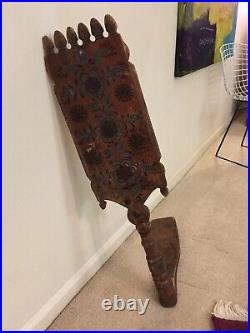


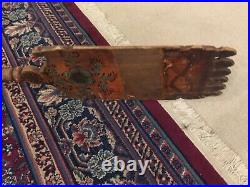
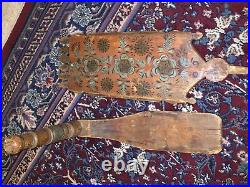
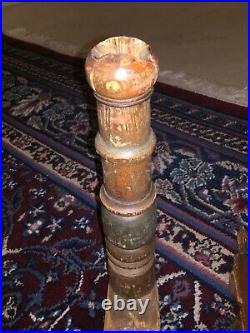
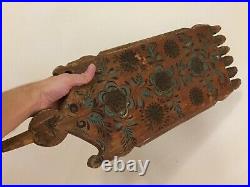

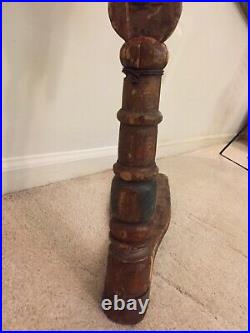
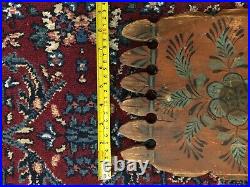

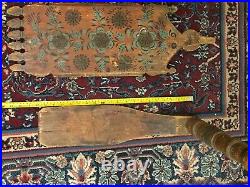

96.5×22.8×50.8 cm. Rare Antique 18th Century Russian Primitive Wool Spinning Board. Very old and special item. This is what Ive found on the web about this artifact and others like it copied and pasted below. It was all in Russian so I had to use google translate. Please forgive my syntax & spelling errors. Also if you know anything more about the exact region that object is from, please let me know. Perhaps not a single instrument of peasant labor was decorated so diversely and lovingly as a spinning wheel. It captures the spirit from the power of folk imagination and art when you see carved, inlaid even with mirrors! Painted even at the ends! , Ridge, teremkovy, light and dark, children’s and adult spinning wheels, spinning wheels, pressing bowls from all over Russia! Of course, such an intricate object not only adorned the peasant hut, but also warmed the soul of the tireless spinner, in the full sense brightened up the endless monotonous work. The spinning wheel was a valuable gift: the father gave it to his daughter, the groom to the bride, the husband to his wife. In some places, according to custom, the groom had to make a spinning wheel with his own hand, and break the old parent’s wheel as a sign of engagement. Many spinning wheels, in addition to the paintings, contained dedicatory inscriptions like Whom I love that I give, advice, teachings: Spin, take care of the spinning wheel, pray for the father of God. Or something like this: “Strands, my spinner, strands of nelenis” or you could immediately read the crafty answer: “I would be glad to spin, they called me to visit” (spelling saved). Almost all Russian folk wood painting came to us from spinning wheels. I must say that the spinning surfaces are not so simple: the “turrets” above, and the “earrings below, and the sides are carved, and the stand with an” apple. It is this deception that brings many aspiring artists down. Especially if they try to repeat some sample of a painting taken from a book illustration – a fragment. This “exact copy”, transferred to the blackboard, often becomes almost a parody. And all because the would-be artist did not see the whole sample. Therefore, it is very important to visit museums and exhibitions, inspect objects from all sides. This, by the way, will also help those who judge folk art as somewhat primitive, sloppy, careless, and thus forgive themselves for these flaws. When you see a large surface of a spinning wheel in nature, from all angles, then thoughts about inaccuracies and negligence no longer arise, but you think with admiration: I would have grown to such simplicity! Now let’s get acquainted with the spinning wheel device. They were of two types: with a crest and with a blade. Ridgebacks were common in the central, southern Russian provinces and in the Volga region. And with blades – in the North, as well as in the central provinces, in the Urals, in Siberia, in Altai. I sit on an aspen, I look through a maple, I shake a birch tree – this old Russian riddle about the spinning wheel fully describes what it was made of. The bottom was cut from aspen or linden, the comb was made of hard wood, most often of maple, but the spindle was birch. Spinning wheels of the 19th century. The spinning wheels-combs were collapsible and consisted of two parts, the comb itself and the bottom (gusno, diaper, bottom) where it was inserted. On the lower Vychegda there was a different painting. A complex plant ornament in the form of bouquets of roses with lush blossoming flowers and green foliage was applied to the blades of spinning wheels against a cinnabar or bright blue background. Plant motifs were applied in red, blue, yellow with toning of lighter tones and contour black outline of some details. Such were the Gorodets spinning wheels with the famous painted bottoms. It seems, why was it necessary to try so hard on the painting, which will not be visible to anyone under the sitting spinner? But no, just imagine how beautiful this decoration picture! Was on the log walls of the hut, where it was hung while the spinner was idle! Spinning wheels with a blade – a shovel, a mask, a head, a feather – variously called the upper part of such spinning wheels – were collapsible or, more often, made from a single piece of pine or spruce with a rhizome so that both a diaper and a shovel were immediately obtained. Therefore, such spinning wheels were called “piggybacks”, “root-eared”. Spinning and weaving were the most laborious of all types of work that fell on the shoulders of a peasant woman. Almost five months of the year, from November to March, she spent at the spinning wheel. In the hut, singing, the maiden. Spins, and, winter friend of the nights. A splinter is bursting in front of her. Alexander Sergeevich Pushkin wrote. The spinning work often continued after midnight, and it was necessary to use a torch by inserting it into the light, next to which (for fire prevention purposes) there was a barrel of water. A basket of cranberries was placed on a bench nearby. Because sour cranberries contributed to the secretion of saliva, which the spinner from time to time moistened the thread. Hand spinning was very slow. The processed linen fiber – the tow – was tied to the upper part of the spinning wheel – the blades, and the spinner sat on the spinning wheel’s seat – the bottom, installed on a bench, and with his left hand carefully pulled the thread out of the tow, twisting it with a spindle. How much dexterity and patience it took to make the thread thin, even and strong: if you pull a little, it will break harder, and a little weaker – it will be too thick or uneven. Pulling out a thread of sufficient length, the spinner wound it on a spindle, and repeated the whole operation from the beginning. The most skilled spinner, working from dawn to dawn, could strain no more than three hundred meters of yarn per day. And to get at least 15 meters of fabric, it was necessary to make at least 20 thousand meters of yarn! Therefore, the girl began to spin and prepare a dowry for herself at the age of 6 – 8. The spindles with strained threads – spinning lobes were put into a special box – a urine bowl. Its walls were painted as smartly as the spinning wheel itself. With urinals and spinning wheels, the girls went to get-togethers, or supraki, – funny parties. There the girls sat down on benches, began to spin, sung songs. Soon guys came to the hut. The hut was quickly filled with people, work alternated with singing, games and dancing see fig. The beautiful spinning wheel was the pride of the owner. She carried her to the party, holding her by the leg, so that everyone could see the carved or painted outfit of the spinning wheel. It is interesting that of the many hundreds of spinning wheels that are now kept in our museums, none repeats the other. So it seems that each spinning wheel is endowed with its own individual features, has its own unique character. The types of spinning wheels have developed in ancient times. Each relatively small area had its own shape of the spinning wheel, its own decoration techniques. Spinning wheels of the Russian North (Vologda, Arkhangelsk regions) were famous for their carvings and paintings. The patterns repeated the ancient symbols of the sun, stars, earth, water element – circles, squares, rhombuses, jagged and straight lines. Spun flax, spun flax. Come to me, my dear. With a hook under the window. Paintings of the Northern Dvina and Mezen. Folk painting, born on the banks of the Northern Dvina and Mezen rivers, is a bright and distinctive art. These schools of folk art emerged in the 19th century. Severodvinsk painting unites several large centers. Among them, the Permogorsk, Rakul, Boretskaya paintings stand out. Another very interesting painting of the Arkhangelsk region is the Mezen painting. The range of household items that the painting decorated and transformed was very wide: ladles, brackets, dishes, salt licks, tues, nabirukhs, boxes, chests, cradles, sledges and much more. The spinning wheels were especially famous for the richness and variety of painting. The decor of each item is individual, the arrangement of the ornament is subordinated to the shape of the object. Painting turned ordinary objects of peasant life into genuine works of art. The basis of the Permogorsk, Rakul and Boretsk painting is made up of plant motifs, and for the Mezen painting, in addition to plant elements, geometric ornaments, amazing birds and thin-legged red horses are characteristic. In all these paintings, the main means of expression are line, contour and silhouette, and color complements the images. Obviously, all types of Severodvinsk painting are rooted in ancient Russian art: monumental painting, icon painting, miniatures and ornamentation of books. Folk craftsmen transferred many of the techniques and motives of book miniatures to painting. The manner in which the characters’ clothes are depicted, the color, simplicity and brevity of the drawing are very close to the miniatures. Many compositional techniques are also taken from book miniatures and icon painting: narration, combination of scenes of different times in one composition, etc. The leading theme of Severodvinsk painting is the poeticized life of the people and native nature. Two Vepsian spinning wheels from the Babaevsky district, dating from the late 19th – early 20th centuries. Baltic spinning wheels echo the Russians. Gorodets spinning wheel – bottom. Arkhangelsk region, Kargopol district. Svejka, below is a salt marsh. The original, bright painting, which was born in the open spaces of Povazhye, is Shenkurskaya, or as it is sometimes called Vazhskaya, primarily spinning painting. A painted Vazha spinning wheel was usually bought by a father for his daughters, who were entering the age of brides. The election of the bride, as a rule, took place at parties beginning with the Feast of the Intercession. Girls came here with work, with spinning wheels. In a dark hut, illuminated by the faint light of a torch or a kerosene lamp, a bright, elegant spinning wheel attracted attention to the girl. Antique painted spinning wheel. Shenkurskaya (important) painting, Russian North, Povazhye. Material: wood, shenkurskaya (important) paint Its in excellent collectible condition, without restoration. Represents historical, artistic and collection value! The earliest dated painted spinning wheels that have survived to our time date back to the sixties of the 19th century. And their number was still insignificant17. By the end of the 19th century, the number of manufactured vazhsky spinning wheels and “painters” who painted them increased significantly, and the 1920s of the 20th century can be considered the true flourishing of their production. After that, in the difficult 30s and 40s, this craft gradually faded away. The word “painter” comes from the German “maler” which means painter. It was first used in Russian in 166518. At the end of the 19th century, handicraft painters were called painters, who were engaged in painting, coloring, cutting painted surfaces “like a tree”, painting patterns and inscriptions through a stencil19. The first painters, icon painters and painters who were engaged in painting work recorded written sources in the 60s of the 19th century20, at that time the first painters appeared in the vicinity of Shenkursk, including in the village of Litvinovo21, where the art workshop of TOS Rukomeslo. In the 90s, the first masters appeared in Glubokovka22, which gave the name to one of the types of Shenkur painting. Shenkur painting, as it was found out in the course of its study, had a polycentric character23, that is, there was no single center of its formation. And by the beginning of the twentieth century, a special style of Shenkur painting had already formed and four centers were formed: Shegovarsky, Yedem, Padengsky and Glubokovsky. Povazhya’s painted spinning wheels are distinguished by their brightness, pattern, and decorativeness. On a red-orange or bright orange background of the spinning wheel’s blades, there are three rosette flowers framed by curved leaves, buds, and smaller flowers, and each spinning wheel is unique, since the options for decorative cuts are infinitely varied24. In the paintings of the Vaja spinning wheels, the images of the eternal renewal of nature vary: buds turning into flowers, flowers giving birth to fruits, and fruits giving life again25. At the same time, Shenkur paintings, in contrast to paintings in a free brush manner, despite their ornamentation, are very graphic, therefore, when painting them, special care is required, one might even say calligraphy26. In addition to spinning wheels, peasant painters in this area of Povaz’ya painted other household items: children’s toys, parts of weaving looms, cooper’s utensils, holiday arches, birch bark baskets27. And their goods were scattered throughout the district thanks to the Sretenskaya and Evdokievskaya Fair. The item “Rare Antique 18th Century Religious Russian Primitive Wool Spinning Board” is in sale since Monday, October 19, 2020. This item is in the category “Antiques\Primitives”. The seller is “leeparker” and is located in New York, New York. This item can be shipped to United States, Canada, United Kingdom, Denmark, Romania, Slovakia, Bulgaria, Czech republic, Finland, Hungary, Latvia, Lithuania, Malta, Estonia, Australia, Greece, Portugal, Cyprus, Slovenia, Japan, Sweden, South Korea, Indonesia, Taiwan, South africa, Belgium, France, Hong Kong, Ireland, Netherlands, Poland, Spain, Italy, Germany, Austria, Bahamas, Israel, Mexico, New Zealand, Singapore, Norway, Saudi arabia, United arab emirates, Qatar, Kuwait, Bahrain, Croatia, Malaysia, Chile, Colombia, Panama, Jamaica, Barbados, Bangladesh, Bermuda, Brunei darussalam, Bolivia, Ecuador, Egypt, French guiana, Guernsey, Gibraltar, Guadeloupe, Iceland, Jersey, Jordan, Cambodia, Liechtenstein, Sri lanka, Luxembourg, Monaco, Macao, Martinique, Maldives, Nicaragua, Oman, Peru, Pakistan, Paraguay, Reunion, Viet nam, Uruguay, Philippines, Ukraine, Costa rica, Trinidad and tobago, Guatemala, Honduras, Antigua and barbuda, Aruba, Belize, Dominica, Grenada, Saint kitts and nevis, Saint lucia, Montserrat, Turks and caicos islands, Cayman islands.
- Style: Naive, Primitive
- Category: Antiques
- Featured Refinements: Antique Spinning Wheel
- Date of Creation: Pre-1800
- Type: Flowers
- Material: Wood
- Original/Reproduction: Original
- Listed By: Dealer or Reseller
- Region of Origin: Russia
- Color: Brown
- Maker: Russia
